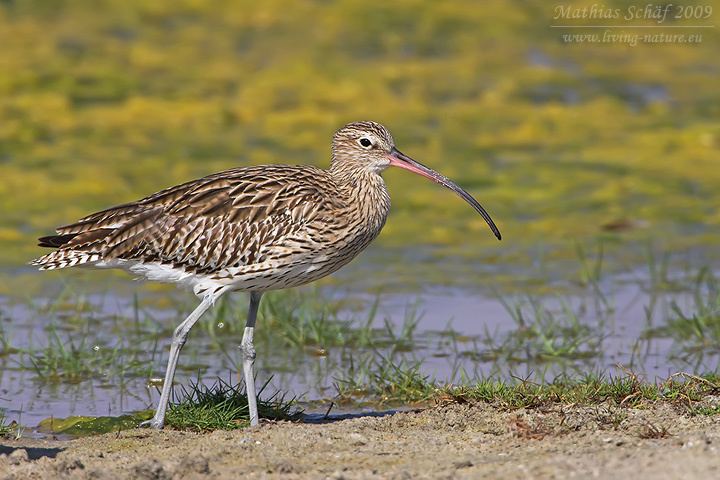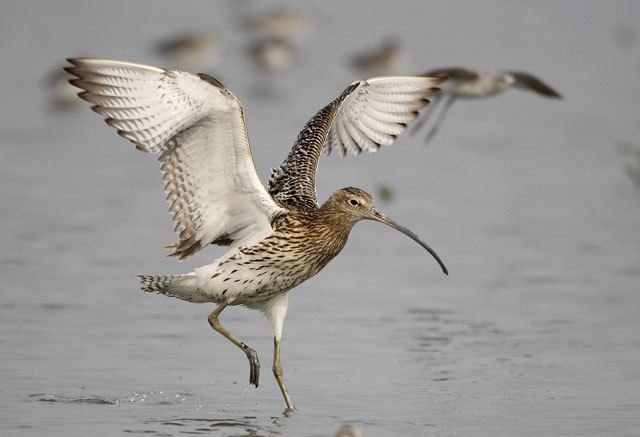Subclass Neornithes Superorder Neoaves Scientific name Numenius arquata Rank Species | Phylum Chordata Infraclass Neognathae Higher classification Curlew | |
Similar Curlew, Bird, Common redshank, Black‑tailed godwit, Whimbrel | ||
The Eurasian curlew (Numenius arquata) is a wader in the large family Scolopacidae. It is one of the most widespread of the curlews, breeding across temperate Europe and Asia. In Europe, this species is often referred to just as the "curlew", and in Scotland known as the "whaup" in Scots.
Contents

This is the largest wader in its range, at 50–60 cm (20–24 in) in length, with a 89–106 cm (35–42 in) wingspan and a body weight of 410–1,360 g (0.90–3.00 lb). It is mainly greyish brown, with a white back, greyish-blue legs and a very long curved bill. Males and females look identical, but the bill is longest in the adult female. It is generally not possible to recognize the sex of a single Eurasian curlew, or even several ones as there is much variation; telling male and female of a mated pair apart is usually possible however.

The familiar call is a loud curloo-oo.
The only similar species over most of the curlew's range is the whimbrel (N. phaeopus). The whimbrel is smaller and has a shorter bill with a kink rather than a smooth curve. Flying curlews may also resemble, albeit not existing in the same area, bar-tailed godwits (Limosa lapponica) in their winter plumages; however, the latter have a smaller body, a slightly upturned beak, and legs that do not reach far beyond their tail tips. The Eurasian curlew's feet are longer, forming a conspicuous "point".

The curlew exists as a migratory species over most of its range, wintering in Africa, southern Europe and south Asia. Occasionally a vagrant individual reaches places far from its normal range, such as Nova Scotia and the Marianas. It is present all year in the milder climates of the United Kingdom and its adjacent European coasts.

Eurasian curlew others
Etymology
The English name "curlew" is imitative of the Eurasian curlew's call, but may have been influenced by the Old French corliu, "messenger", from courir , "to run". It was first recorded in 1377 in Langland's Piers Plowman "Fissch to lyue in þe flode..Þe corlue by kynde of þe eyre". The genus name Numenius is from Ancient Greek noumenios, a bird mentioned by Hesychius. It is associated with the curlew because it appears to be derived from neos, "new" and mene "moon", referring to the crescent-shaped bill. The species name arquata is the Medieval Latin name for this bird, derived from Latin arcuatus, "bow-shaped", and again referring to the shape of the bill.
Subspecies
There are three subspecies of the Eurasian curlew:
It is generally wary. Highly gregarious outside the breeding season, the Eurasian curlew feeds by probing soft mud for small invertebrates, but will also pick small crabs and earthworms off the surface if the opportunity arises.
The nest is a bare scrape on taiga, meadow, and similar habitats. Each curlew lays between 3 and 6 eggs in April or May and incubates them for about a month until they begin to hatch.
The curlew is one of the species to which the Agreement on the Conservation of African-Eurasian Migratory Waterbirds (AEWA) applies.
Formerly classified as a species of Least Concern by the IUCN, it was suspected to be rarer than generally assumed. Following the evaluation of its population size, the classification was found to be incorrect, and it was consequently promoted to Near Threatened status in 2008. Though it is a common bird, its numbers are noticeably declining. In Ireland, for example, the breeding population is estimated to have declined by 86% in the last 30 years.
